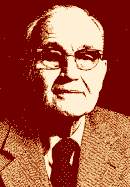 (source)
(source)
|
Willem van Bemmelen
(14 Apr 1904 - 19 Nov 1983)
Dutch geologist whose book, Geology of Indonesia (1949) and his studies of the regional geology of Indonesia drew attention to the significance of island areas in the development of the Earth's crust.
|
Reinout Willem van Bemmelen
Reinout Willem van Bemmelen was educated as a mining engineer but later on preferred being a geologist, with a bias towards volcanology. He was also known for his dedication to geoscience, his tenacity and resilience, as well as being an inspiring teacher.
His studies of the regional geology of Indonesia led to recognition of the importance of island areas in the development of the Earth's crust. Long before others even thought about compiling an article on this archipelagos, he published his biggest contribution, the Geology of Indonesia (1949). Still often cited, this book covers broad aspects of the regional geology of Indonesia, which is prolific in terms of hydrocarbon and other mineral resources. Indonesia is part of the volcanic “ring of fire” and one of the most complex geological settings in the world because it lies at the junction of three major tectonic plates (Pacific, Indian-Australian, and Eurasian). Van Bemmelen also researched continental drift and the winds of the equatorial stratosphere, but did not embrace the theory of tectonic plates.
As late as 1972 he still discounted global tectonic plates as an explanation for crustal features. Instead, he proposed his own Undation Theory. In a book, Geodynamic Models, an Evaluation and a Synthesis, he explained the structure of the Earth's crust in terms of “undations,” crustal upwarps and downwarps from 10,000 to 1 km across, produced by vertical movements of material in the upper mantle. His theory was descriptive, rather than mathematical, and based on the observable geographical and geological land forms. Thus wave-like undations account for the uplift of mountains, and basins are a downwarp. To explain continental drift and seafloor spreading within his theory, he merely attributed the effects to the gravitational slumping and lateral sliding of a bulging undulation. In his book, his detailed descriptions included the origin of the Alps and the cordillera of the Americas, the formation of associated rifts, and petrologic processes in terms of large to small undations.
| Year | Age | Events |
| 1904 | 0 | Born on 14 April |
| 1912 | 8 | Decided to become a volcanologist |
| 1920 | 16 | Left Batavia for Holland |
| 1927 | 23 | Graduated as a mining engineer; obtained doctorate in technical science cum laude |
| 1930 | 26 | Married Lucie van der Bos |
| 1932 | 28 | Field mapping in Java and Sumatra |
| 1933 | 29 | Studied soil mechanics |
| 1940 | 36 | Became chief of the volcanological survey of Netherlands East Indies |
| 1942 | 38 | Interned by Japanese |
| 1946 | 42 | Evacuated to Holland |
| 1949 | 45 | Finalized his book, Geology of Indonesia. Became associate professor in the University of Utrecht |
| 1950 | 46 | Consultant to Bataafshe Petroleum Maatschapij. Reappointed as a professor in Economic Geology at the University of Utrecht |
| 1954 | 50 | Finalized his book Mountain Building |
| 1961 | 57 | Became ordinary professor in the University of Utrecht |
| 1970 | 66 | Received van Waterschoot van der Gracht Medal |
| 1983 | 79 | Passed away due to cancer |
- Science Quotes by Willem van Bemmelen.
- 14 Apr - short biography, births, deaths and events on date of Bemmelen's birth.
- Color picture of R.W. Van Bemmelen (300 x 400 px)
- The Geology of Indonesia, by R.W. van Bemmelen. - book suggestion.


![Willem van Bemmelen quote: [In geology,] As in history, the material in hand remains silent if no questions are asked.](https://todayinsci.com/V/VanBemmelen_RW/VanBemmelenRW-SilentThm.jpg)





